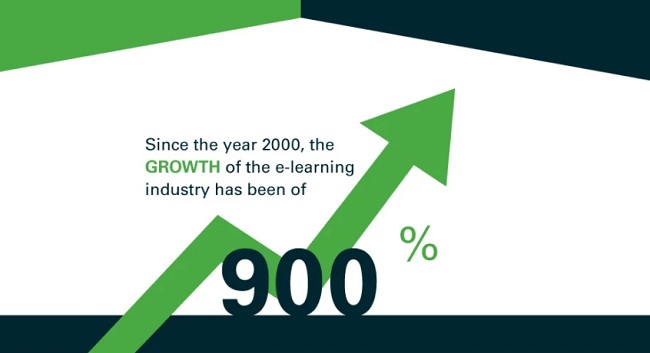Utilizing Hybrid Learning Techniques For A Future Ready Education
24th February 2023

The pandemic has forced educators to rapidly adapt the way of hybrid learning and teaching. Educators had to move from in-person to online learning at a moment’s notice for future ready education. And while this has been difficult, it has also given us a taste of what the future of learning and teaching might look like.
According to startupbonsai.com, since 2000, the digital learning industry has grown by 900% making it the fastest-growing market in the education industry by a large margin.

In the future, we will likely see a hybrid model of learning that combines in-person and online instruction. This hybrid model will offer the best of both worlds - the flexibility and convenience of online learning, with the personal touch of in-person instruction.
Many educators and institutions are now looking for ways to create a more hybrid learning environment that can combine the best of both online and offline learning.
One approach that has been gaining popularity is Virtual Online Teaching (VOLT). VOLT is a type of hybrid learning that combines aspects of both online and offline learning. It offers the flexibility and convenience of online learning, while still providing the structure and support of offline learning.
If you are interested in setting up a hybrid learning environment for your students, read on to learn everything you need to know about Virtual Online Teaching (VOLT) for a future ready education!
What is Hybrid Learning?
Hybrid Learning is a method of teaching and learning that combines elements of both online and offline learning. It's an approach that takes advantage of the best parts of both traditional and digital learning, allowing for an easy transition between the two.
Hybrid learning involves both synchronous and asynchronous teaching, as well as a combination of live and self-directed instruction. This type of learning is ideal for teachers who want to make the most of their students' time and smartphone devices. With hybrid learning, students can take advantage of the convenience of online learning, while still receiving personalized, face-to-face instruction which could change the course of the future of teaching and learning.
Additionally, because the content is future ready education and organized in advance, there is less risk of boredom or frustration.
How is Hybrid Learning different from Blended Learning?
Hybrid Learning and Blended Learning are similar in that they both incorporate elements of both online and offline instruction. However, there are a few key differences between the two.
For example, hybrid learning is more focused on the integration of online and offline learning as a way to generate an educational experience that is more efficient and effective. In contrast, blended learning involves a more mixed approach with online and offline activities being blended together.
Hybrid learning is also more technology-driven than blended learning. With hybrid learning, there is a greater emphasis on leveraging technology for instruction which allows students to collaborate effectively, engage in synchronous sessions, and have better access to educational resources. Additionally, it is often used to provide students with more personalized and individualized learning experiences.
5 hybrid learning and teaching tips for future ready education:
- Define Your Goals:
The first step to a successful hybrid learning environment is to define your goals. What kind of learning environment do you want to create for a future ready education? What do you want students to gain from the experience? Clarifying your objectives will help you to plan out your instruction and create activities accordingly.
Take some time to think about what you want students to learn in the hybrid learning environment. Once you have determined your goals, you can create plans to implement them.
Consider creating learning objectives for each subject area or course in the hybrid learning environment. This will help you focus your teaching and ensure that your instruction is effective and aligned with your goals for a successful future ready education.
- Establish Routines:
Routines are an important part of any learning environment - hybrid or otherwise. Establishing a set of routines will provide structure and consistency for students. Routines can include anything from attendance routines to morning meetings to weekly activities.
In addition, to providing structure, routines can also create a sense of security for students. Knowing what to expect each day will help students feel more comfortable in the hybrid-learning environment. Finally, routines can help keep students on track and ensure that they are completing their work on time.
- Utilize Technology:
Technology is an important part of any hybrid learning and teaching environment. You can use technology to create virtual classrooms and facilitate video conferencing. You can also use technology to assign and receive assignments, provide feedback, and allow students to collaborate with each other.
Technology can also be used to create engaging activities such as interactive videos, quizzes, and games. These activities can help to keep students engaged and interested in the learning process. Finally, technology can provide an easy way for students and teachers to communicate.
- Manage Your Time:
Time management is a crucial skill for any hybrid learning environment. As an educator, it is important to be aware of how much time you are spending on each task.
This will help you to ensure that you are giving enough attention to each student and ensure that everyone is on track. Creating a schedule and planning ahead can be helpful. When creating your schedule, it is important to consider the student’s needs and your own.
For example, if you know that some students need more time for certain activities, you can schedule extra time for those activities.
- Keep an Open Mind:
It is important to keep an open mind while transitioning to a hybrid learning and teaching environment. As a teacher, you may need to be open to trying new techniques and approaches.
You may have to experiment and see what works best for you and your students. Also, be open to feedback from students and parents. Take the time to listen to their concerns and suggestions and make adjustments as needed.
Finally, remember that the hybrid-learning environment is still a work in progress and it will take time to figure out what works and what doesn't.
Final Thoughts:
Hybrid Learning is an emerging concept that has been gaining traction in the wake of the pandemic. By combining the best of both online and offline learning, hybrid learning can offer a more efficient and flexible approach to education for a better future of learning. It allows students to take advantage of the convenience of online learning, while still receiving personalized instruction from their teacher.
Hybrid learning or Virtual Online Teaching (VOLT)is an ideal solution for today's educational system and for future ready education as well. It can help reduce costs, promote student engagement, and provide students with an enhanced learning experience. If you are interested in setting up a hybrid-learning environment in your classroom, remember to plan ahead and ensure that you have all the necessary resources and materials to make the most of this approach.
Written By: Rimpa Ghosh